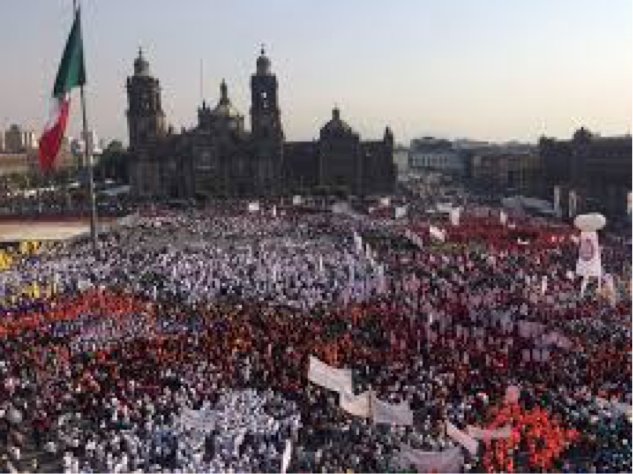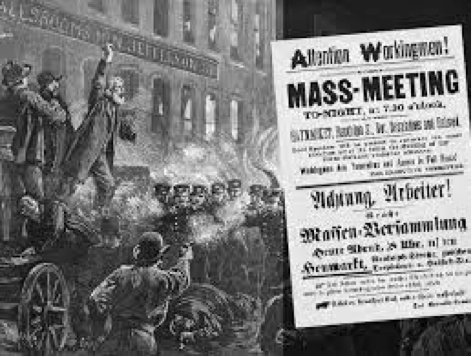El Día Internacional de los Trabajadores
International Workers' Day celebrated on May 1
El domingo pasado, muchas personas aquí en West Liberty celebraron “May Day”, el primero de mayo. Aquí en los Estados Unidos, muchas personas preparan canastas de plantas, flores y dulces para regalar a sus vecinos u otros seres queridos. Lo típico es dejar la canasta en el porche del recipiente suertudo, tocar el timbre e ir huyendo, así el alegado no está seguro de quién trajo la sorpresa.
Este día tiene sus raíces en antiguas culturas de Grecia y Roma, donde, al llegar la primavera, fueron honrados los dioses y diosas de plantas, flores, uvas y otros símbolos de la naturaleza.
Sin embargo, en los países de América Latina, el primer de mayo tiene otro significado, uno que, irónicamente, tiene sus raíces de aquí en los Estados Unidos: el Día del Trabajo, o el Día de los Trabajadores.
Este día recuerda los movimientos laborales que marcaron la segunda parte de Siglo XIX, y más específicamente la lucha que estaba realizando en esa época en ciertas partes de los Estados Unidos para establecer la jornada laboral de ocho horas al día (ocho horas para laborar, ocho horas para dormir, ocho horas para el auto-desarrollo).
En ese tiempo, lo más común era que las personas tuvieran que trabajar entre 12 y 16 horas el día, y hasta los niños lo hacían. El primero de mayo de 1894, varias organizaciones laborales declararon un día de huelga para promover la idea de la jornada diaria de 8 horas. La fecha Primero de Mayo pronto sería sinónimo del movimiento laboral, la jornada de ocho horas y los trabajadores en general.
Empezaron a reconocer la fecha primero en otros países industrializados en Europa, como los Países Bajos y Francia. Fue celebrado también en España y reconocido oficialmente en 1931. Simultáneamente, la fecha iría siendo reconocida en los países de habla hispana en América, al igual que muchos países asiáticos y africanos.
En los Estados Unidos y Canadá, la fecha sería trasladada al primer lunes de septiembre.
No obstante, en todos los países de América Latina, se celebra el Día del Trabajador el Primero de Mayo. Las oficinas y otros trabajos están cerrados y es un día libre pagado para los trabajadores. Los sindicatos de labor celebran con desfiles, comidas y marchas. Aunque las organizaciones laborales y algunos partidos políticos se encargan de la organización de las celebraciones, se reconoce en todo el país como un día para celebrar a los trabajadores y conmemorar los logros del movimiento laboral.
ENGLISH VERSION
Last Sunday, many people here in West Liberty celebrated May Day, the first of May. Here in the United States, many people make baskets of plants, flowers, and candy to give to their neighbors or other loved ones.
Sometimes, people leave the basket on the porch of the lucky recipient, ring the bell, and run away, so that the person is not sure who brought the nice surprise.
This day has its roots in the ancient cultures of Greece and Rome, where, when spring came, the gods and goddesses of plants, flowers, grapes and other symbols of nature were honored.
However, in Latin American countries, the first of May has another meaning, one that, ironically, has its roots here in the United States: Labor Day, or Workers' Day.
This day recalls the labor movements that marked the second part of the 19th century, and more specifically the struggle that was taking place at that time in certain parts of the United States to establish the eight-hour work day (eight hours to work, eight hours for sleep, eight hours for self-development).
At that time, the most common thing was that people had to work between 12 and 16 hours a day; many times, even children did it. On May 1, 1894, various labor organizations declared a strike to promote the idea of an 8-hour day. The May Day date would soon become synonymous with the labor movement, the eight-hour day, and workers in general.
The date was first in other industrialized countries in Europe, such as the Netherlands and France. It was also celebrated in Spain and officially recognized in 1931. Simultaneously, the date would be recognized in the Spanish-speaking countries of America, as well as many Asian and African countries.
In the United States and Canada, the date would be moved to the first Monday in September.
However, in all Latin American countries, Labor Day is celebrated on May Day. Offices and other jobs are closed and it is a paid day off for workers. Labor unions celebrate with parades, potlucks and marches. Although labor organizations and some political parties organize the celebrations, it is recognized throughout the country as a day to celebrate workers and commemorate the achievements of the labor movement.
Mark Plum is an Index contributing writer who produces stories, along with Vanessa Espinoza, on Latino culture in the West Liberty area. Plum is open to almost any ideas for stories and can be contacted by calling him at 219-471-0748 or by e-mail at mplum@wk.k12.ia.us, or by writing to the Index office at indexnews@Lcom.net
Plum dice que está abierto a casi cualquier idea en cuanto a sus historias; se puede ponerse en contacto con él marcándole al 319-471-0768 o escribiéndole al mplum@wl.k12.ia.us. The series is associated with a special grant the newspaper won from the Iowa Newspaper Foundation.
Comments




